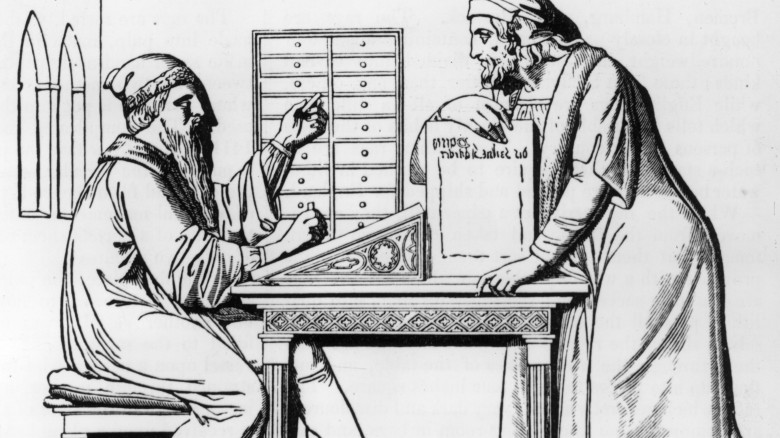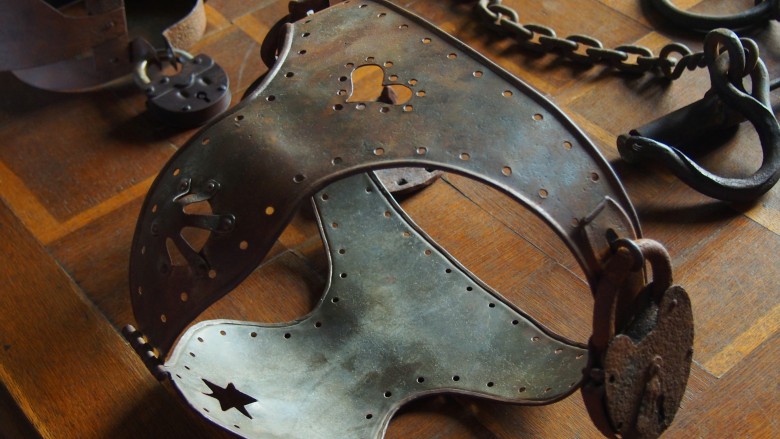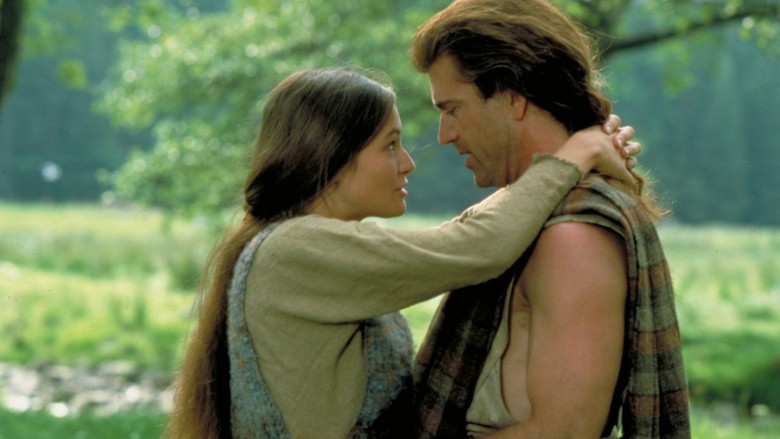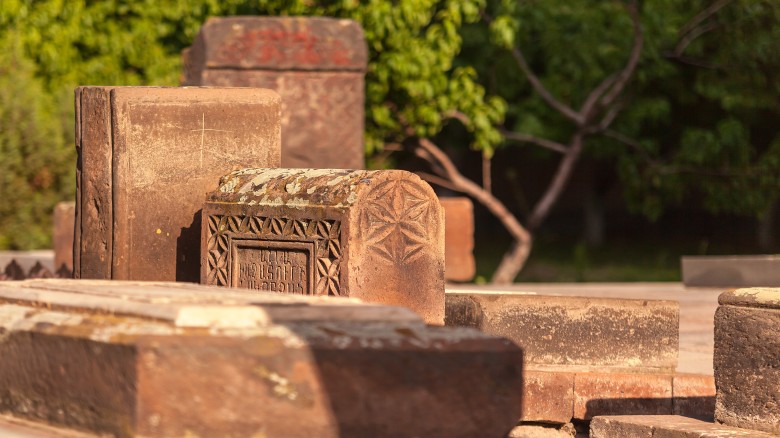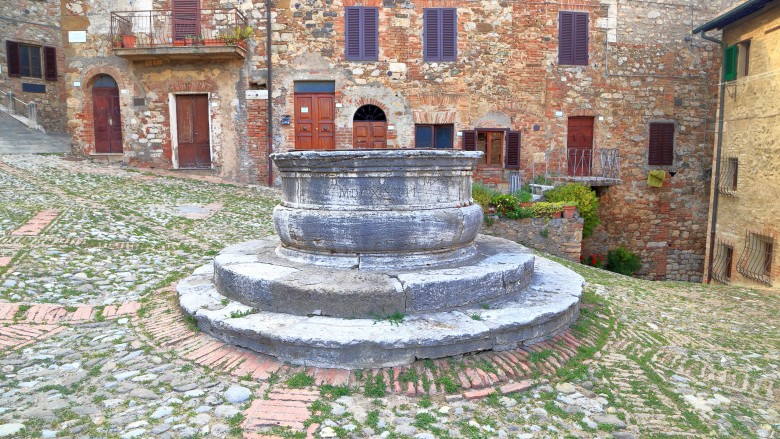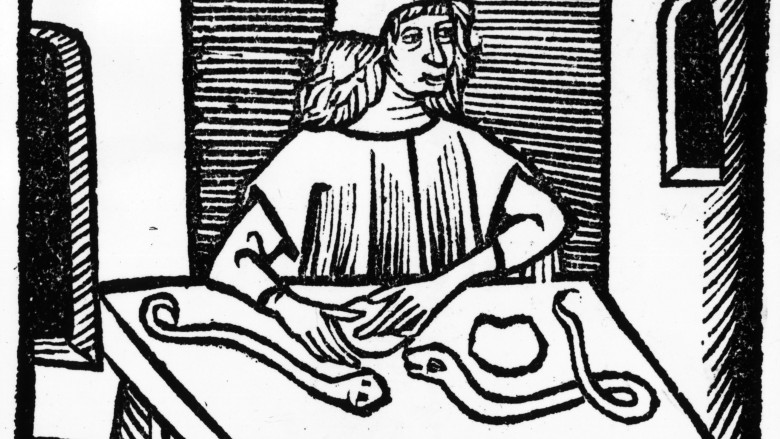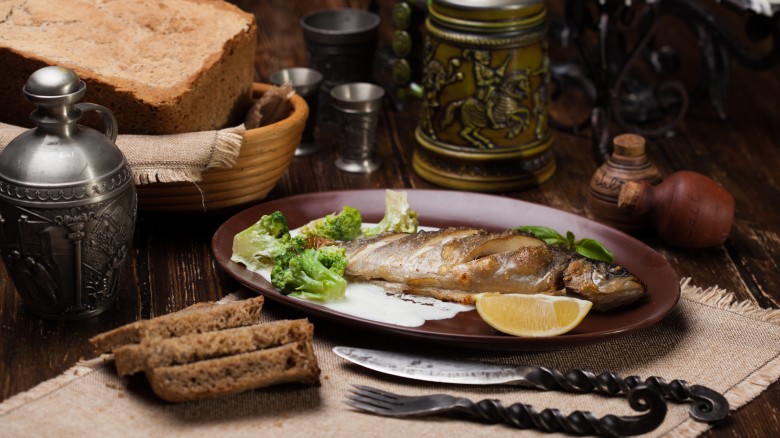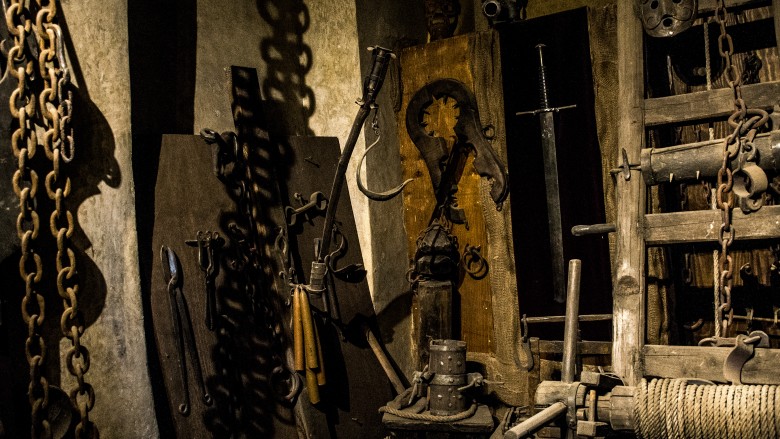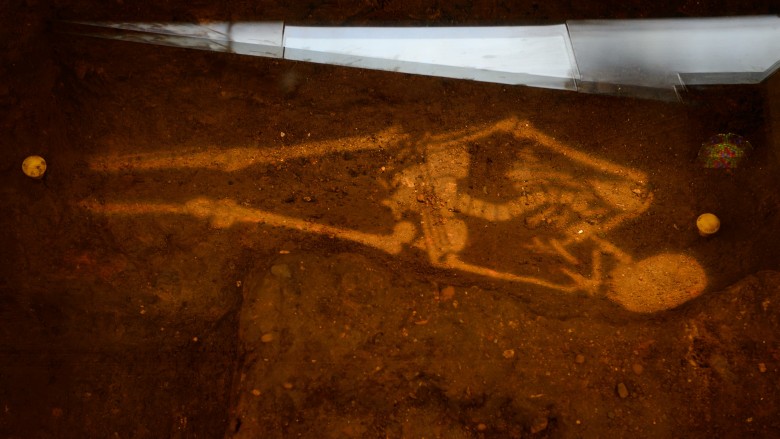False Facts About The Middle Ages Everyone Thinks Are True
If most of your knowledge about the Middle Ages comes from Monty Python and The Holy Grail, you've probably got a particular image of what life was like then. But the Middle Ages spans a huge amount of time—from the fall of Rome in 476 to the much less exact date of "sometime in the 14th century," and a lot can happen in that many years. A lot of what you probably believe about the Middle Ages didn't happen at all, and we're not even talking about that story about replacing horses with coconuts.
Christianity stomped out scientific progress and invention
One of the biggest myths about the Middle Ages is that a strict religious belief system—and distractions like the plague—put an end to scientific thought and advancement. It's such a powerful idea that it even gave rise to the era's other name, the Dark Ages (they weren't called that because there was no such thing as electricity yet). But it's absolutely untrue.
Let's start with the Church. Instead of stepping on forward thinkers, the medieval Church established a curriculum for university students that included science and math. By the 11th century, scholars were bridging the gap between ancient Greek teachings and the science of the Renaissance, and they were reimagining the Bible as a sort of guide for uncovering the truth about the world. Since God created the world, the reasoning went, understanding the world—and science—would bring people closer to God.
Now, how about some medieval-era advancements? A set of 16th-century engravings outlined advancements of the Middle Ages, and they included printing (the printing press would come in 1439), water- and windmills, eyeglasses and corrective lenses, watches and clocks, the processes for making silk and pigments for paints and dyes, the magnetic compass, and the development of foodstuffs like sugar and olive oil. By the 11th century, the Church was also developing what they called mixed sciences, which combined observations of the physical world with mathematics, creating mechanics. Optics, botany, mineralogy, zoology, and physiology were also taught, along with astrology and phrenology, but hey, not every college class can be a winner. Scientific advancement was alive and well in the Middle Ages, and even though people might not have figured out satellite TV yet, that didn't make them idiots.
Chastity belts were popular
We all know the deal: guy goes off to battle, can't trust his wife to keep her underclothes on, so he puts her in a metal bikini bottom and takes the key with him. Not only is this not true, but it's likely the medieval equivalent of a joke.
The very first time anyone ever saw the depiction of a metal virtue-protector was in the 1405 book Bellifortis. As legit as that seems, it's important to note that context is everything, and also included in the book are some of the author's favorite fart jokes. That leads historians to believe the book was a satire on an idea from ancient Rome, where untying a knotted cord looped around the bride's waist was a part of wedding night traditions. The cord was meant to symbolize chastity, not ensure it, and if you take that concept, and add a heaping layer of barbaric medieval ways, you've got something sweet and innocent turned into something with teeth. Also, consider the sheer impracticality of such a thing—hygiene concerns would make it unwearable in a few days.
But, you argue, you've seen metal chastity belts in museums, and museums wouldn't lie, right? Read the fine print, and you'll find that most of those are Victorian-era gadgets made with a nudge and a wink at the barbaric times of lore. There's nothing we like more than feeling superior to our ancestors.
Everyone believed the Earth was flat
The flat Earth is one of those special theories dragged out to make a clear distinction between those in the know, and, we'll just say, those not in the know. Calling someone a Flat Earther is a pretty clear insult, and it all goes back to the Middle Ages, when those unenlightened people thought that's what our planet looked like.
Only, the Flat Earthers of today don't have much in common with the people of the Middle Ages because those people already knew the Earth wasn't a flat disc. There were plenty of people who did think the world was flat—like those living in ancient Greece, Mesopotamia, and Egypt, but note the word "ancient." People started realizing that the Earth wasn't flat as early as the sixth century BC, and over the course of the next few hundred years, word got out, and the whole thing was pretty widely accepted by the first century BC.
In this case, we know how our myth got started, and it was Washington Irving's fault. Irving published A History of the Life and Voyages of Christopher Columbus in 1828, and even though it had "history" in the title, it was less history and more super-embellished demi-fiction. Not content to have Columbus exploring beyond the edges of the known world, he added the part where Columbus argued against the "popular" idea that they were going to sail right off the horizon. The idea got repeated as fact in a late 19th-century work on how dangerous the views of the Church had been in stopping scientific theory, and the rest is, as they say, misconstrued history.
Jus primae noctis was a common thing
Even if you don't speak a bit of Latin, you know what we're talking about, especially if you've seen Braveheart. It's the right of a king, nobleman, or any other upper-crust man to step into a new groom's place on their wedding night. Braveheart even hinges on the idea, and if you know anything about how historically incorrect Braveheart is, you probably won't be surprised to learn this is another glaring error, all made in the name of telling a better story because history, apparently, is boring.
The idea goes back a long time, and it first shows up in Gilgamesh. The poem talks about the king Gilgamesh putting the idea into practice, and it shows up again in the histories of Herodotus. It's scattered across a huge number of texts, but do you know what's missing? Any evidence that a single real lord or king ever decided to be the ultimate bad wedding guest. The closest we've got is 15th-century Sweden, when a lord decided it was totally a great idea to demand either jus primae noctis or a modest fee ... and there's no indication that he ever took advantage of the first option. It's thought to be just one more symbolic gesture in a list of symbolic gestures, as creepy as it is. Sorry to break it to you, Mr. Gibson.
Women just had kids and tended the house
When it comes to women in the Middle Ages, movies typically only give them a few tasks: giving birth, dying while giving birth, stirring the pot of mystery meat, and looking concerned when their man rides off to find some adventure, because home is boring. But that was totally not the case in real life, and women were extraordinarily equal to men in the types of work that they took on.
Women were expected to care for the house and the rug rats, sure, but at the same time they were sweeping small furry critters out of the pantry, they were also expected to help with the harvest and aid in whatever the area's major industries were. That could be everything from textiles and fabrics to baking, and once you got into the town, you found women running the family shops, mastering the trades passed down through the generations, and managing taverns and inns. Hop up a step on the social ladder, and you had women filling major positions of power. We're not just talking about queens, either—we're talking about religious organizations including convents and even co-ed monasteries, where women rose to the top and had seniority over men and women alike.
Part of this was because of the image of the Virgin Mary as a respected ideal for both men and women, and part was out of necessity. In 1300, plague reduced London's population by half, but work—and life—had to go on. Widows were running businesses and managing trades, and young women were being signed on as apprentices by the score. Women also ran their own businesses alongside husbands, joining trade guilds on their own and creating their own networks. Women also made up the overwhelming majority of one surprising profession in the Middle Ages, and it's one we're particularly partial to: the brewer.
People only lived into their thirties
We can totally see how this one got started. Life was more dangerous then, surely, especially considering nothing came with warning labels. But there's a difference between life span and life expectancy.
Life span is how long a particular person lives, and you only have one life span. (If you have more than one, let us know, we want to talk to you.) Life expectancy changes as you age, and it measures your chances of surviving your age's particular dangers, measured against everyone else's successes and failures. For as long as we've been recording history, the human life span has stayed around the same—people have always been able to make it into their seventies, eighties, and nineties.
Life expectancy is why you think everyone in the Middle Ages was yelling at those damn kids to get off their lawn by the time they were 25. Imagine two parents, William and Mary as our parents. They have four kids: Jack, John, Betty, and Betsy. Betsy dies at the ripe old age of 70. One of the other kids dies in childbirth, the other two die from some childhood illness before they're a year old. William dies in a farming accident at 35, but Mary makes it to 60. That makes the average life expectancy of this particular family only 28 years, but that doesn't mean that no one lived past that magic number. Once you made it past a few crucial points in life—like childhood, and child-bearing age—you had a pretty good chance of living to see gray hair, wrinkles, and to be able to use the phrase "kids these days."
Water wasn't safe, so people drank beer and wine
We're not ashamed to admit that we're a little disappointed this one's not true. Life was tough in the Middle Ages, and the idea that people were facing it while just slightly drunk made us happy.
General ignorance says that water wasn't safe but beer was, but it turns out that every part of that's just untrue. Most medieval towns were built around sources of fresh water, and that included not just lakes and streams but places where you could dig a well, too. Most potential contamination came from industry, and those industries—like tanning and dyeing—were legally required to follow the medieval equivalent of clean water legislation to make sure people had plenty to drink. There were even harsh penalties put in place for contaminating drinking water. Cities went even further, and whole infrastructure was devoted to clean water. In 1236, London's Great Conduit was built, bringing clean water into a pumping house for distribution all over the city. If you were rich enough, you could even have your house directly connected to the water supply, so yes, some medieval homes even had indoor plumbing.
When it comes to the beer-drinking, sure, there was a lot of that going on. But it wasn't necessarily for the same reason we knock back a beer after a long day, and beer was instead a major source of nutrition. It was weaker than today's brews, and when you're working the fields all day, there's nothing that's going to keep you going better than a beer. That hasn't changed much at all.
Medieval medicine was completely insane
You might think of medieval medicine as being the type where someone's most likely to drill a hole in your skull to release the evil spirits, but medical knowledge was a real thing then, and it was so weirdly advanced that we're only now realizing some of their crazy cures worked.
Let's take one particular burn treatment: taking a live snail and letting it slime the burned area. Gross, sure, but it totally worked—so well that we still use it today in our fancy modern hospitals. Snail slime has anti-inflammatory, antibiotic, and antiseptic properties and contains some chemicals that aid skin repair and in pain relief. If you had eye problems, you might be prescribed a mash of onion, garlic, wine, and bull's gall that's been marinating for nine days. Go on, smear that on your face ... and it will work. Letting the mixture sit for nine days turns it into a goo with some major antibiotic properties, and researchers at Nottingham University are trying to figure out how we can use it today.
Even though they still believed in healing based on the zodiac, they had the basics for quite a few key medical concepts, like examining bodily fluids—like urine—for clues as to what was wrong with a person. We won't be heading off to a medieval hospital any time soon, but it wasn't as much of a random chop shop as you might think.
Spices became popular because people were trying to improve rotten meat
Aside from common sense, we know this one's completely untrue for a couple of big reasons, and the biggest is simply that spices were extraordinarily expensive. With efficient transportation still ages away, being able to buy cinnamon and ginger from the Far East meant that you were rich, and you weren't going to be wasting spices on bad meat.
Eating spoiled meat wasn't a thing, either, and there were laws in place to prevent bad meat from even being sold. Butchers could find themselves in the stocks if they were caught selling spoiled meat, and those who didn't get their meat from a store only killed and prepared what they were going to eat. We even know where this particular rumor came from: a 1939 text called The Englishman's Food: Five Centuries of English Diet. It was written by a vitamin researcher and mentions the use of spice in one section ... and completely contradicts itself in another section, which goes to show just how important it's that you read the whole thing.
You might find yourself tortured in an iron maiden
Read almost anything on medieval torture, and you'll find stories about the iron maiden. Nasty stuff, right? Fortunately for medieval prisoner, it was never a thing.
The first time an iron maiden is ever mentioned in history texts was in one from the late 1700s, in reference to an execution that supposedly happened in 1515. It expanded on the idea of a nail-studded box, one that had been around since around 100 BC. Ancient stories talked about a nail-covered chair, which definitely isn't the same thing. Just ask someone to try the two out.
Do some digging into medieval torture, and you'll find that most of our information comes from the 18th and 19th centuries, when people were eager to paint themselves as living in a more civilized time. No actual evidence of the use of iron maidens has even been found, and even those famous ones—like the Iron Maiden of Nuremberg—were from the 19th century, and some earlier references? They were hoaxes. While we're on the subject, there's no evidence that the Pear of Anguish—a torture instrument inserted in certain orifices—was ever a thing, either, and that makes us a little more confident in our decision to visit the Middle Ages if we ever get our hands on a time machine.
Dental care was non-existent
Dental care is today synonymous with torture, but we usually think of medieval people as having no such thing as dental care and hygiene. But while this was pre-toothpaste, it was also pre-Skittles. With no widespread access to sugar, most people had decent enough teeth.
With the discovery of the remains of Richard III, researchers got a look at the preserved teeth of a king, and found that it had more cavities than they expected (likely from his diet) but also irregular tartar buildup (which implied cleanings) and extractions done by a professional.
In the early 1400s, the Italian professor Giovanni de Arcoli wrote a treatise on dental care, proving that the basic concepts we know and hate today were in practice even then. That included avoiding sweet and sticky foods, cleaning your teeth after every meal and before bedtime, and not chomping on something so hard it might break or chip your teeth. He even detailed the process of saving a decaying tooth by filling it with gold, so next time you go and get bad news at the dentist, you can at least take a bit of comfort in knowing people have been hating their dentists for hundreds and hundreds of years.

